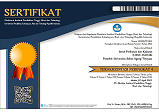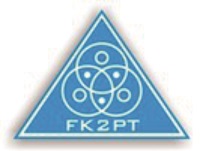Vulnerability of Baitfishes of Handline and Lift Net Fishing Gear that Landed in Kendari, Bitung, Wakatobi and Larantuka Fishing Port
Abstract
Keywords
Full Text:
PDFReferences
Andrade HA, Garcia CAE. 1999. Skipjack tuna fishery in relation to sea surface temperature off the southern Brazilian coast. Fisheries oceanography, 8(4):245-254.
Ardelia V, Boer MF, Yonvitner Y. 2018. Precautionary Approach dalam Pengelolaan Sumberdaya Ikan Tongkol (Euthynnus affinis, Cantor 1849) di Perairan Selat Sunda. Tropical Fisheries Management Journal, 1(01):33-40.
Argue AW, Kearney RE. 1983. An assessment of the skipjack and baitfish resources of New Zealand. New Caledonia: South Pacific Commission. 24p.
Cayré P, Marsac F. 1993. Modelling the yellowfin tuna (Thunnus albacares) vertical distribution using sonic tagging results and local environmental parameters. Aquatic Living Resources, 6(1):1-14.
Dransfeld L, Gerritsen HD, Hareide NR, Lorance P. 2013. Assessing the risk of vulnerable species exposure to deepwater trawl fisheries: the case of orange roughy Hoplostethus atlanticus to the west of Ireland and Britain. Aquat. Living Resour., 26 4 (2013):307-318 .
Druon JN, Chassot E, Murua H, Soto M. 2016. Preferred feeding habitat of skipjack tuna in the eastern central Atlantic and western Indian Oceans: relations with carrying capacity and vulnerability to purse seine fishing. IOTC Proceedings. IOTC–2016–WPTT18–31:1-24
Duffy LM, Griffiths SP. 2019. Assessing attribute redundancy in the application of productivity-susceptibility analysis to data-limited fisheries. Aquat. Living Resour. 32(20):1-11.
Froese R, Pauly D. 2020. FishBase (version Feb 2018). In: Species 2000 & ITIS Catalogue of Life, 2020-04-16 Beta (Roskov Y.; Ower G.; Orrell T.; Nicolson D.; Bailly N.; Kirk P.M.; Bourgoin T.; DeWalt R.E.; Decock W.; Nieukerken E. van; Penev L.; eds.). Digital resource at www.catalogueoflife.org/col. Akses 19 November 2019
Gillett R. 2011. Replacing purse seining with pole-and-line fishing in the central and Western Pacific: Some aspects of the baitfish requirements. Marine Policy, 35(2):148-154.
Gilman E, Owens M, & Kraft T. 2014. Ecological risk assessment of the Marshall Islands longline tuna fishery. Marine Policy, 44:239-255.
Griffiths S, Duffy L, Aires-da-Silva A. 2017. A preliminary ecological risk assessment of the large-scale tuna longline fishery in the eastern Pacific Ocean using Productivity-Susceptibility Analysis. In 8th Meeting of the Scientific Advisory Committee of the IATTC, 8-12 May 2017, La Jolla, California, USA. Document SAC-08-07d (pp. 1-21).
Heupel E, Auster PJ. 2013. Eco-labeling seafood: Addressing impacts to vulnerable seafloor species, communities, habitats and ecosystems in data-poor regions. Marine Policy, 38:8-15.
Hohne-Sparborth T, Adam MS, Ziyad A. 2013. A socio-economic assessment of the tuna fisheries in the Maldives. IPNLF Technical Report 5. International Pole and Line Foundation. Retrieved December 30, 2018, from http://ipnlf. org/perch/resources/socio-economicassessment-of-the-tuna-fisheries-in-the-maldives. pdf.
Hordyk AR, Carruthers TR. 2018. A quantitative evaluation of a qualitative risk assessment framework: Examining the assumptions and predictions of the Productivity Susceptibility Analysis (PSA). PloS one, 13(6):1-32.
Howell EA, Hawn DR, Polovina JJ. 2010. Spatiotemporal variability in bigeye tuna (Thunnus obesus) dive behavior in the central North Pacific Ocean. Progress in Oceanography, 86(1-2):81-93.
Itano DG, Holland KN. 2000. Movement and vulnerability of bigeye (Thunnus obesus) and yellowfin tuna (Thunnus albacares) in relation to FADs and natural aggregation points. Aquat. Living Resour., 13 4 (2000):213-223.
Jiménez S, Domingo A, Abreu M, and Brazeiro A. 2012. Risk assessment and relative impact of Uruguayan pelagic longliners on seabirds. Aquat. Living Resour., 25(4):281-295.
Khatami AM, Yonvitner Y, Setyobudiandi I. 2019. Tingkat kerentanan sumberdaya ikan pelagis kecil berdasarkan alat tangkap di perairan Utara Jawa. Tropical Fisheries Management Journal, 2(1):19-29.
Lehodey P, Hampton J, Brill RW, Nicol S, Senina I, Calmettes B, dan Sibert J. 2011. Vulnerability of oceanic fisheries in the tropical Pacific to climate change. In book: Vulnerability of Tropical Pacific Fisheries and Aquaculture to Climate Change Publisher: SPC FAME Digital Library. Editors: Bell JD, Johnson JE, Hobday AJ. New Caledonia: SPC (Secretariat of The Pacific Community). p: 434-492.
Lucena-Frédou F, Kell L, Frédou T, Gaertner D, Potier M, Bach P, Ménard F. 2017. Vulnerability of teleosts caught by the pelagic tuna longline fleets in South Atlantic and Western Indian Oceans. Deep Sea Research Part II: Topical Studies in Oceanography, 140:230-241.
McCully SR, Scott F, Ellis JR, Pilling GM. 2013. Productivity and susceptibility analysis: application and suitability for data poor assessment of elasmobranchs in northern European seas. Collect Vol Sci Pap, 69(4):1679-98.
Milton DA, Blaber SJM, Rawlinson NJF. 1991. Age and growth of three species of tuna baitfish (genus: Spratelloides) in the tropical Indo‐Pacific. Journal of fish biology, 39(6):849-866.
Monintja DR, Mathews CP. 2000. The skipjack fishery in Eastern Indonesia: distinguishing the effects of increasing effort and deploying rumpon FADs on the stock. In Pêche thonière et dispositifs de concentration de poissons, Caribbean-Martinique, 15-19 Oct 1999.
Patrick WS, Spencer P, Ormseth OA, Cope J, Field J, Kobayashi D, Gedamke T, Cortés E, Bigelow K, Overholtz W, Link J, Lawson P. 2009. Use of productivity and susceptibility indices to determine stock vulnerability, with example applications to six US fisheries. Seattle: NOOA. 90p
Patrick WS, Spencer P, Link J, Cope J, Field J, Kobayashi D & Bigelow K. 2010. Using productivity and susceptibility indices to assess the vulnerability of United States fish stocks to overfishing. Fishery Bulletin, 108(3):305-322.
Phillip C. 2001. Atlantic Blue Marlin and Yellowtin Tuna: Comparative Population Vulnerability to Fishing Mortality. American Fisheries Society Symposium, Vol. 25:219-224.
Phillips SRM, Scott F, Ellis JR. 2015. Having confidence in productivity susceptibility analyses: A method for underpinning scientific advice on skate stocks?. Fisheries research. 171(2015):87-100.
Puspita R, Boer M, & Yonvitner Y. 2017. Tingkat Kerentanan Ikan Tembang (Sardinella fimbriata, Valenciennes 1847) dari Kegiatan Penangkapan dan Potensi Keberlanjutandi Perairan Selat Sunda. Tropical Fisheries Management Journal, 1(1):17-23.
Rawlinson NJF, Milton DA, Blaber SJM. 1992. Tuna baitfish and the pole-and-line industry in Kiribati. Canberra: Australian Center for International Agricultural Research. 92p.
Tiroba G, Rawlinson NJF, Nichols PV, Leqata JL. 1990. Length-frequency analysis of major baitfish species in Solomon islands. In Tuna baitfish in the Indo-Pacific region, Proceedings of the workshop, Honiara, Solomon Islands (pp. 114-133).
Williams AJ, Allain V, Nicol SJ, Evans KJ, Hoyle SD, Dupoux C, Dubosc J. 2015. Vertical behavior and diet of albacore tuna (Thunnus alalunga) vary with latitude in the South Pacific Ocean. Deep Sea Research Part II: Topical Studies in Oceanography, 113:154-169.
Yonvitner, Tamanyira M, Ridwan W, Habibi A, Destilawati D, Akmal SG. 2019a. Kerentanan Perikanan Bycatcth Tuna dari Samudera Hindia: Evidance dari Pelabuhan Perikanan Pelabuhanratu. Tropical Fisheries Management Journal 2(1):1-10.
Yonvitner, Setyobudiandi I, Ernawati Y, Zairion, Mashar A, Akmal SG. 2019b. Penuntun Praktikum Biologi Perikanan. Cetakan Pertama. IPB Press. 85 hlm.
DOI: http://dx.doi.org/10.33512/jpk.v9i2.6340
Refbacks
- There are currently no refbacks.



_-_Copy1.png)